New York Times Chocolate Chips Cookies {from Jacques Torres} – These cookies are unique in that both bread flour and cake flour are used in the dough; the bread flour gives incredible chewiness and the cake flour keeps them light.
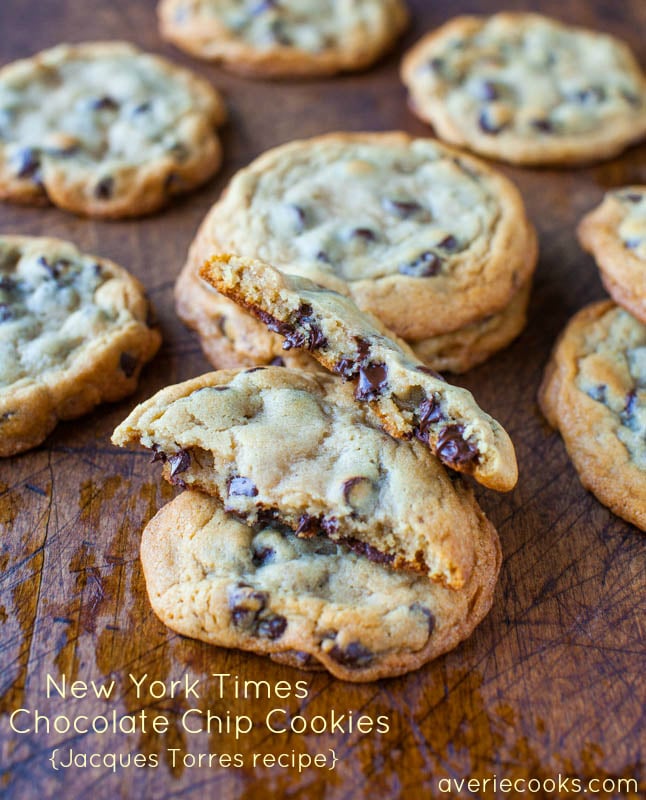
I’ve been wanting to make the New York Times Chocolate Chip Cookies since 2008 and finally got around to it. Better late than never.
The Times recipe is adapted from Jacques Torres and some people refer to these cookies as ‘The Jacques Torres Recipe’ instead of the New York Times Recipe. Whatever title it’s given, the recipe has been discussed, dissected, and now I’m tossing my thoughts into the ring, too.
The recipe is full of nuances and uniquities, making it unlike any other chocolate chip cookie recipe I’ve tried. The full recipe yields 18 five-inch diameter cookies that use a whopping 3.5 ounces of raw dough each. That’s two to three times the size of most homemade cookies and puts these squarely into the jumbo-bakery-sized cookie realm. We didn’t need 18 whoppers all at once, fearing they would go stale before we’d eat them all, and so I halved the recipe, yielding nine jumbo cookies and one slightly smaller cookie. You could likely make the full batch of dough and either freeze the pre-baked balls of dough or freeze the finished cookies. I’m sure either freeze similarly well to other doughs or finished cookies if you prefer to make the full batch.
Halving the recipe was a good choice because the cookies are great on baking day as expected, but by the second day they were so-so, and what lingered into the third day was not my kind of cookie. They were hard, dry, and a bit crumbly. Some people expect that cookies just don’t hold up into the second and third day, but I am used to the Cooks Illustrated Thick And Chewy Recipe and various deviations I’ve created with it over the years. Those cookies do stay soft for days, thanks to a higher ratio of brown to granulated sugar. Because brown sugar absorbs atmospheric moisture, the cookies, paradoxically, get softer rather than dry out, as time passes.
The NYT recipe is unique in that it calls for two types of flour, bread flour and cake flour. Bread flour has a higher protein level than other flour, about 12.7% protein, which is a couple points higher than all-purpose flour, which is usually in the 1o- to 11.7-percent range, depending on the brand. The higher the protein level, the more gluten that’s present, the stronger the rise, and also the chewier the resulting item. Bread flour creates chewiness in bread, and as I’ve discovered it does the same for cookies and I loved the resulting extra chewy effect.
Cake flour is on the opposite side of the spectrum. Soft, downy, light, and airy. It’s what angel food cakes and tender-crumbed birthday cakes are made from and although it’s great in cake, it’s typically not used for cookies because it’s too soft and cookies baked with it won’t have good structure. However, because it’s paired in conjunction with the big strongman known as bread flour, the two balance each other.
The downside of using cake flour is that it has a powerful aroma and smells strongly of a box of cake mix. I love the scent of cake mix, and the smell of birthday cake or Funfetti cake, but not inside my chocolate chip cookies. I have a very keen sense of smell and with every bite of chocolate chip cookie, it felt like I was simultaneously eating a white graduation party sheetcake or birthday cake and I did not care for this.
An additional consideration is that the average person may not keep both bread and cake flour on hand. I do, so not a biggie for me, but a consideration nonetheless if you have to purchase two bags of flour just to make cookies. However, buy the bread flour anyway because I have lots of bread recipes coming and you’ll need it.
The next consideration is that using a digital food scale is nearly mandatory for these cookies. Many grocery stores sell them in the baking supplies aisle near the flour and sugar and if you order online, you can find deals. I use the EatSmart Precision Pro Digital Kitchen Scale in red. It’s $25, I’ve had it for years,it’s not super fancy, but it gets the job done. I don’t bake by weight as much as smart people in other countries tend to do, but when I do, I’m reminded that I need to do it more often because it makes things so much easier, faster, and more accurate.
For example, bread flour is heavy and dense, and cake flour is light and airy. If measuring by volume in traditional measuring cups, ‘1 cup flour’ can be an inconsistent measurement, whereas measuring by weight on a scale is absolute. The scale also made halving the recipe a breeze. Halving numbers in ounces is much easier than trying to halve fractions and when I have cookie dough on the brain, I’d rather not try to halve fractions in my head with my stand mixer whipping and flour flying.
Additionally, there is no way I could have accurately guessed what a 3.5-ounce mound of dough looked like without using a scale. It’s much more dough than I would have guesstimated, and without a scale, I would have grossly under-estimated it.
The next nuance is that the dough must be chilled for at least 24 to 36 hours before baking. If you are in a must-have-cookies-now mood, these are not the cookies for you as they do require at least a day’s worth of advance planning. The chilled dough may be used in batches, and can be refrigerated for up to 72 hours. In general, chilling cookie dough not only results in cookies that spread less when baked and that stay puffier, but in the case of these cookies, it’s been suggested this waiting period allows the flavors and flours to meld. Since I always chill my dough before baking cookies, sometimes up to four days beforehand, the chilling and waiting period was nothing out of the ordinary for me.
I actually find it easier to make cookie dough one day, store dough balls in the fridge in a little container, and bake them just before I want fresh and hot cookies. Sometimes I bake two balls of dough at a time because nothing beast a just-baked cookie. If within four days or so I haven’t baked off the dough, I toss it into a labeled ziplock and freeze it. When you’re ready to bake the frozen dough, you don’t even need to thaw it and I find baking for an additional minute or two is all that’s necessary.
The recipe also calls for specialty chocolate; chocolate disks which are sold at Jacques Torres Chocolate, and Valrhona fèves, which are oval-shaped chocolate pieces, sold at Whole Foods. I cannot afford to use high end chocolate in cookies, especially in ones I wasn’t sure I’d love. Instead I used my trusty Trader Joe’s semi-sweet chocolate chips and they were more than fine. Whatever kind of chocolate you use, you’ll need lots of it. Halving the recipe required 10 ounces of chocolate and so for a yield of nine cookies in the half batch, that’s over one ounce of chocolate per cookie. A standard bag of chocolate chips usually has ten to twelve ounces of chips in it; so for nine cookies, essentially a whole bag of chocolate chips is needed.
When mixing the chips into the dough, it almost felt like the dough couldn’t possibly hold one more chip and I learned by making this recipe that I can stuff more chocolate into other cookie doughs I make; it will all magically hold somehow. I loved that the cookies were bursting with chocolate chips and were intensely chocolaty. The one ounce-plus of chocolate per cookie is like eating a little chocolate candy bar baked within a cookie. Rich much?
When it came time to bake, almost two full days after mixing the dough, 44 hours to be exact, I weighed the dough balls to ensure I was doing everything as prescribed, down to the tenth-of-an-ounce.
The dough for one NYT cookie is like three of my normal cookies rolled into one massive hunk. Below are three one-ounce mounds that I smooshed together to create one bowling ball of dough. Well, baseball at least. The theoretical advantage to baking cookies this big is that the edges should bake up chewy, while the centers should stay soft. In reality, this theory did not work well with these cookies so I was very skeptical that the baseballs would give me the chewy-yet-soft results I wanted, but they delivered.
I learned something very valuable by making this recipe and if for no other reason than this discovery, I am glad I made these cookies. Since making the NYT cookies, I’ve tried making other types of cookies using two to 2.25-ounces of dough and realize I like them better than my typical one- to 1.25-ounce cookies. Sometimes bigger is better, to a point. I like cookies in the two-ounce range or slightly over, but 3.5 is just too big for a snack for me and is more like a meal, via one cookie.
I did not sprinkle sea salt on them before baking, a personal choice in the interest of taste-testing comparison. I wanted ‘classic’ chocolate chip cookies like I grew up with and since my mom and Grandma never baked cookies with sea salt, I omitted it here.
The recipe indicates to bake the cookies for 18 to 20 minutes at 350F. Because they’re huge, they need more time to bake than typical cookies. I baked the cookies one tray at a time because I have one ‘perfect’ rack in my oven and took no chances with these 44-hours-in-the-making bundles of joy. I baked the first batch of six cookies for 18 minutes and the second batch of four cookies for 16 1/2 minutes. I strongly preferred the 16 1/2-minute cookies and in my oven, baking for 20 minutes according to the recipe, would have ruined them. At 18 minutes, the edges were browned and the tops were on the glossy side; at 16.5 minutes the edges were slightly less browned and the tops were glossier, but still set. I allowed the cookies to cool on the baking tray for 10 minutes, then I placed them on a wire rack. They firmed up very dramatically during the ten minutes and by the time I transferred them to the rack, they had essentially finished cooling.
In any recipe, I tend to use the lower end of listed ranges and treat them as guidelines, not absolutes. Let common sense and your personal taste preferences be your guides when you deem something done. I frequently calibrate and test my oven temperature, and know that it’s functioning up to par. However, I believe baking times in many recipes are too lengthy to create soft and chewy cookies. I prefer Mrs. Field’s style cookies, very ooey and gooey, and overbaking is not the way to my heart. With most any cookie recipe, if you wait to pull them from the oven until they look done, most of the time as they cool, they will set up firmer and crispier than ultimately desired. These were just on the edge of that cliff and in my oven, 16 1/2 minutes (below) would be the max for future batches.
I wanted to love-love-love these cookies and wanted them to be the last cookie recipe I ever needed. I wanted to give them an A+ and if I was going by looks alone, they look exactly like a cookie ‘should’ look to me, and for appearance they get an A+. But we all know life, and cookies, is about more than just looks.
On baking day, for taste, I give them an A+. Fresh and hot out of the oven, they were simply stunning. Then again, most cookies are. In terms of texture, they center is tender and the edges are very chewy. If you like a chewy, sturdy, firm cookie that you really have to use your jaw to cut through, you will love these. They are the opposite of these, which melt in your mouth. There is nothing soft and airy about them, thanks in large part to the bread flour.
My major complaint is that the cookies didn’t age well and by the second and third day they became far too dry, hard, and crumbly for my preference. Especially considering the NYT cookies are so big, and because no one can realistically pound down an entire batch on the first day (holiday parties and feeding football teams not withstanding), I expect the leftovers to hold up for at least 48 to 72 hours. This lack of shelf life is was disappointing and the Cooks Illustrated recipe wins by a long shot here.
The other major issue is that the taste of the cake flour was unpleasantly discernible. I love cake and I love cookies, but not a cake within a cookie when I just want a good, classic, chocolate chip cookie. I do have a sensitive palate and keen sense of taste and smell, and I think things like this may be magnified for me, but even Scott who isn’t a supertaster and normally doesn’t know his zucchini flecks from his chocolate chips, asked me why the cookies smelled and tasted a little bit like birthday cake. Ahem.
Overall, the cookies fall in the B+ to A- range for me. I recommend trying them because you may absolutely love them as millions do and they may become your A+ never-need-another-recipe chocolate chip cookie recipe. Don’t be dissuaded by the two flours, the extended chilling time, or any trepidations in my review. I am simply being very cautious about proclaiming them as the ‘best cookies ever’ because as a food blogger who bakes hundreds of batches of cookies every year, I am judicious and on the tentative side when handing out those solid A ratings. I don’t want every single cookie I make to be ‘the best cookie ever that will change your life’ as I see happen so frequently on blogs.
And on baking day, these were the best and who cares if it was short-lived. That means you’ll just have to eat your way through a batch of these cookies, quickly. There are far worse things.
Pin This Recipe
Enjoy AverieCooks.com Without Ads! 🆕
Go Ad Free
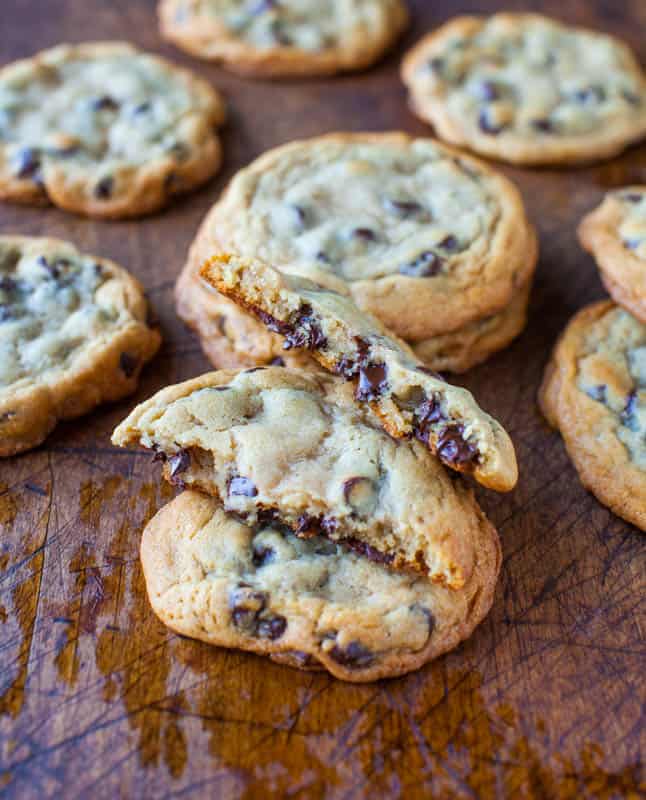
New York Times Chocolate Chips Cookies {from Jacques Torres}
Ingredients
- 2 cups minus 2 tablespoons, 8 1/2 ounces cake flour
- 1 ⅔ cups 8 1/2 ounces bread flour
- 1 ½ teaspoons baking powder
- 1 ¼ teaspoons baking soda
- 1 ½ teaspoons coarse salt
- 2 ½ sticks, 1 1/4 cups unsalted butter
- 1 ¼ cups 10 ounces light brown sugar
- 1 cup plus 2 tablespoons, 8 ounces granulated sugar
- 2 large eggs
- 2 teaspoons vanilla extract
- 1 ¼ pounds bittersweet chocolate disks or fèves, at least 60 percent cacao content (chocolate disks available from Jacques Torres
- sea salt, for sprinkling over cookie dough prior to baking
Instructions
- Sift flours, baking powder, baking soda, 1 1/2 teaspoons sea salt into a large bowl; set aside.
- Using a mixer fitted with the paddle attachment, cream butter and sugars together until very light, about 5 minutes. Add eggs, one at a time, mixing well after each addition. Stir in the vanilla. Reduce speed to low, add dry ingredients and mix until just combined, 5 to 10 seconds (I did about 20 to 30 seconds). Drop chocolate pieces in and incorporate them without breaking them. Press plastic wrap against dough (or place dough in an airtight container) and refrigerate for 24 to 36 hours. Dough may be used in batches, and can be refrigerated for up to 72 hours (I baked mine just shy of two days later, at 44 hours)
- When ready to bake, preheat oven to 350F degrees. Line a baking sheet with parchment paper or a nonstick baking mat; set aside.
- Scoop six 3 1/2-ounce mounds of dough (the size of generous golf balls) onto baking sheet, making sure to turn horizontally any chocolate pieces that are poking up; it will make for a more attractive cookie. Sprinkle lightly with sea salt and bake until golden brown but still soft, 18 to 20 minutes. (I baked first batch of 6 cookies for 18 minutes, and baked second batch of 4 cookies for 16 1/2 minutes; I prefer the 16 1/2 minute cookies). Transfer baking mat or parchment paper to a wire rack for 10 minutes, then slip cookies onto another rack to cool a bit more. Repeat with remaining dough, or reserve dough, refrigerated, for baking remaining batches the next day. Eat warm, with a big napkin.
- Recipe from the New York Times, adapted from Jacques Torres
Notes
Nutrition
Nutrition information is automatically calculated, so should only be used as an approximation.
©averiecooks.com. Content and photographs are copyright protected. Sharing of this recipe is both encouraged and appreciated. Copying and/or pasting full recipes to any social media is strictly prohibited.
Related Recipes
My favorite chocolate chip cookie recipe is the Chocolate Chip and Chunk Cookies. I’ve adapted that recipe to include M&Ms Cookies, Soft and Chewy Smores Cookies, Snickers Cookies, Twix Bar Chocolate Chip Cookies, and many more.
Peanut Butter Oatmeal White Chocolate Chip Cookies – The cookies call for melted butter, and no mixer is required. The higher ratio of brown to granulated sugar keeps them just as soft on day 4 as on day 1. Of all the cookie recipes on my site, people write to me the most frequently about these telling me they made them and really enjoyed them
Chocolate Chip Peanut Butter Oatmeal Cookies – This is essentially the chocolate chip version of the cookie above. The dough base is slightly different, but very similar. I love either version depending on my mood whether I want white or semi-sweet chocolate chips
Chocolate Chip Peanut Butter Oatmeal Skillet Cookie – This is a play on the cookie above and combines three of my favorite cookies into one – chocolate chip, peanut butter, and oatmeal. The edges bake up crispy and chewy, and sweetened condensed milk is baked into the cookie, keeping the interior a literal hot, sweet, and gooey mess
Peanut Butter Chocolate Chunk Cookies (gluten-free) – Favorite Peanut Butter Cookie Recipe – NO Butter, Flour, or White Sugar Used in these soft cookies
Have you ever tried the New York Times Chocolate Chip Cookie recipe? Are you tempted to try it?
What’s your favorite recipe for chocolate chip cookies?
If you have a favorite recipe for chocolate chip cookies, please link it up and tell me why you love it so much. I want to find those buried gems.
My favorite chocolate chip cookie recipe to date is the Cooks Illustrated Thick and Chewy Chocolate Chip Cookie recipe (with photo tutorial) on their site. Ironically, I have never blogged about that recipe. These are the closest.
Until very recently, I didn’t realize there are actually two Cooks Illustrated Chocolate Chip Cookie recipes; the Thick and Chewy, and their newer Perfect Chocolate Chip Cookie recipe. That recipe differs from the Thick and Chewy in that browned butter is used, slightly less overall sugar is used while maintaining a higher brown to granulated sugar ratio, and slightly less flour is used, creating a slightly smaller batch size.
What I enjoy about the Cooks Illustrated recipes are that the butter is melted rather than creamed and so theoretically I don’t have to dirty my mixer to mix the ingredients. However, if I have time, I do get better results when I cream, rather than melt, the butter. And although their recipes don’t call specifically for chilling the dough in advance, I always do; it’s habit and I get better results. The cookies are just the right thickness, the edges are chewy and the centers stay soft. Making them also feels more fun, with less scientific precision required.
However, I have recently been testing some other chocolate chip cookie recipes, and creating some other dough hybrids, and the more cookies I make, the less certain I am of my favorites anymore.
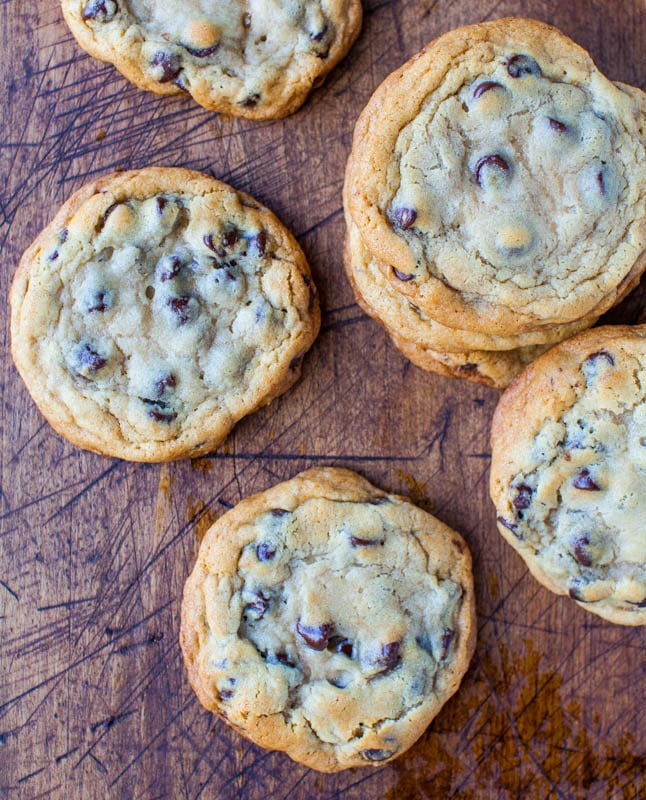
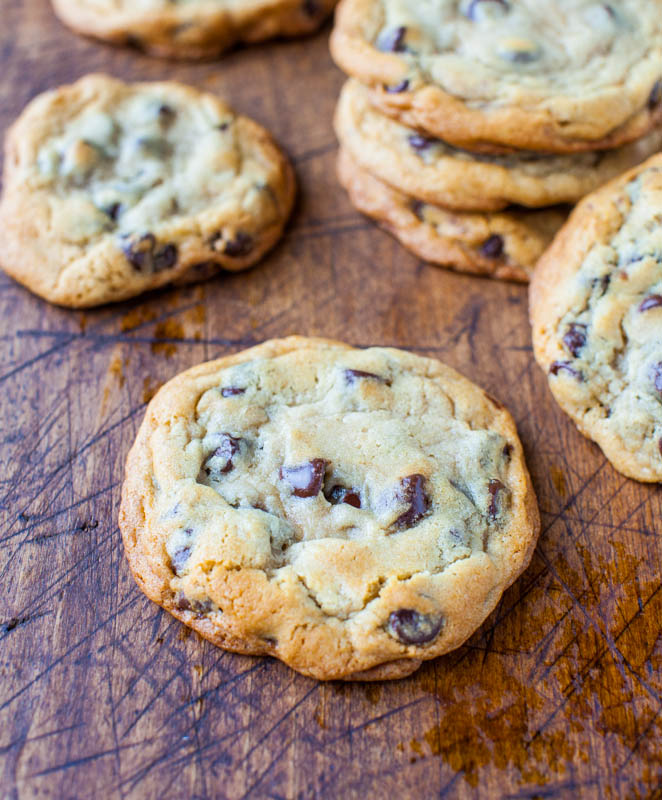
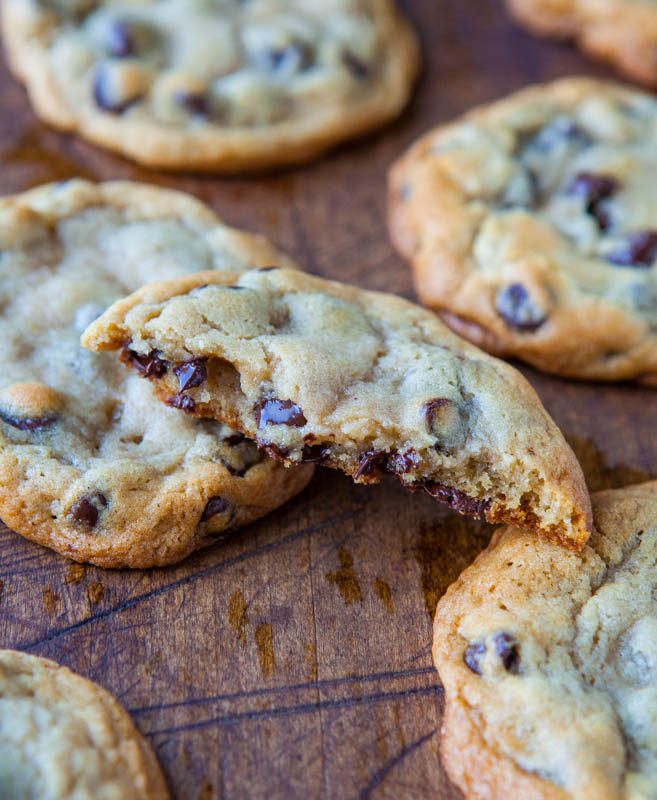
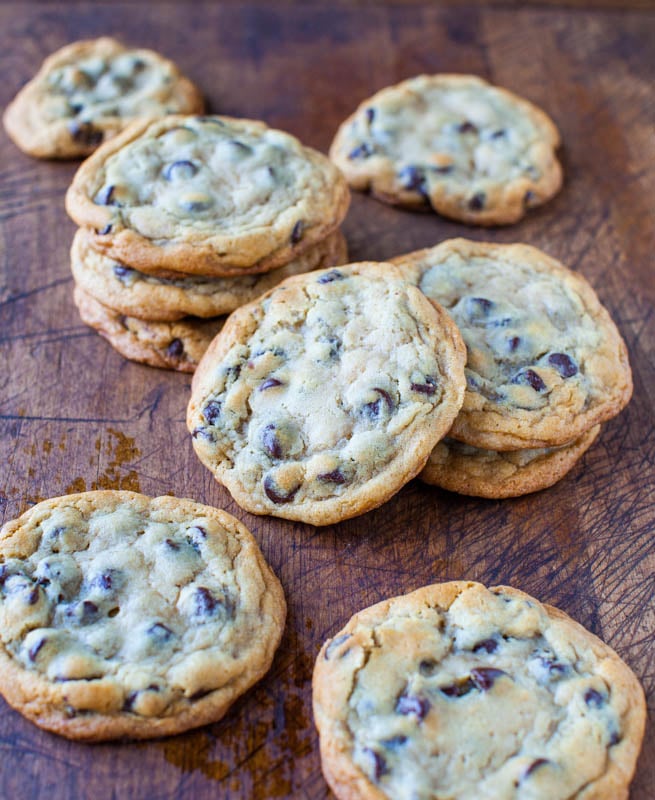
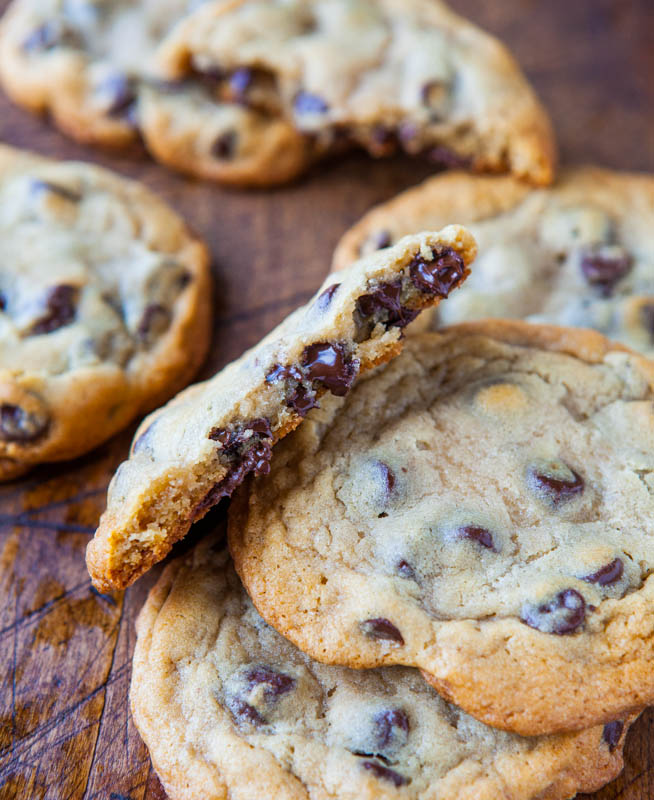
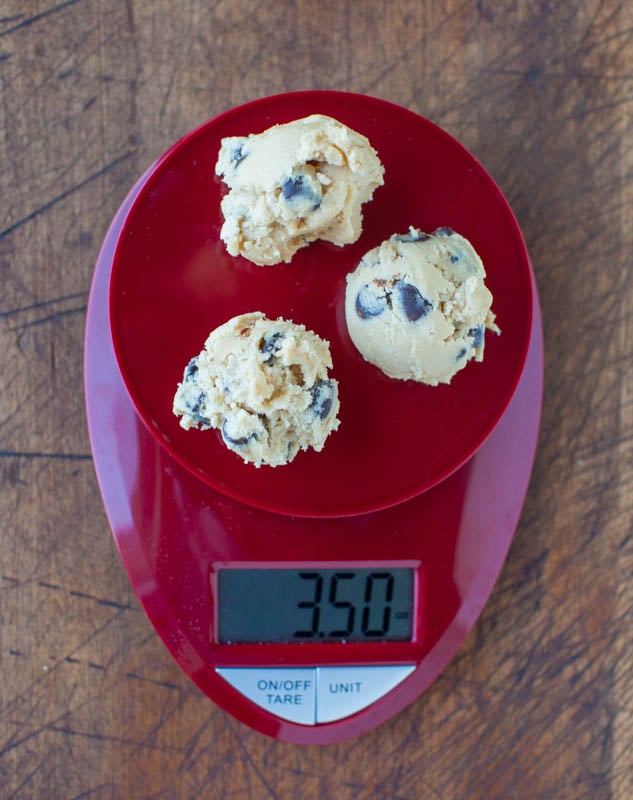
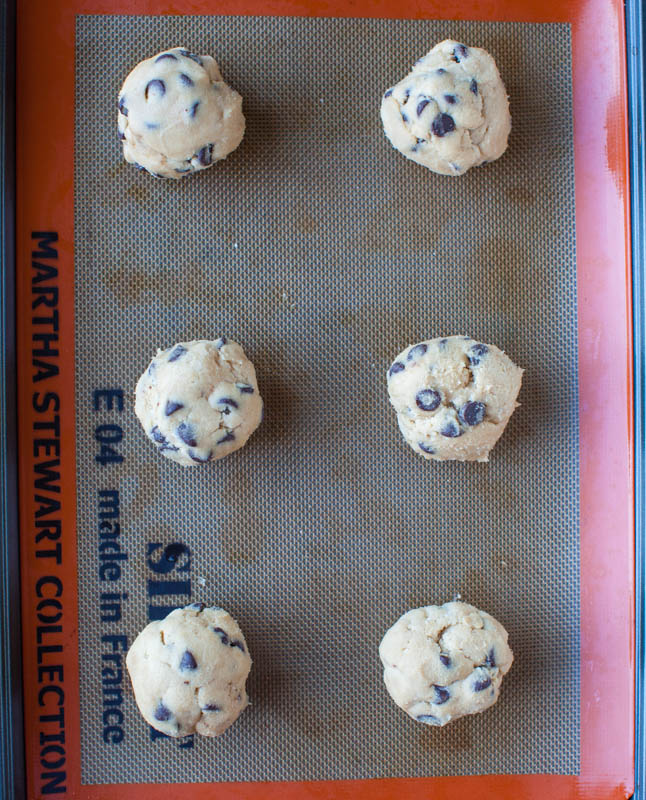
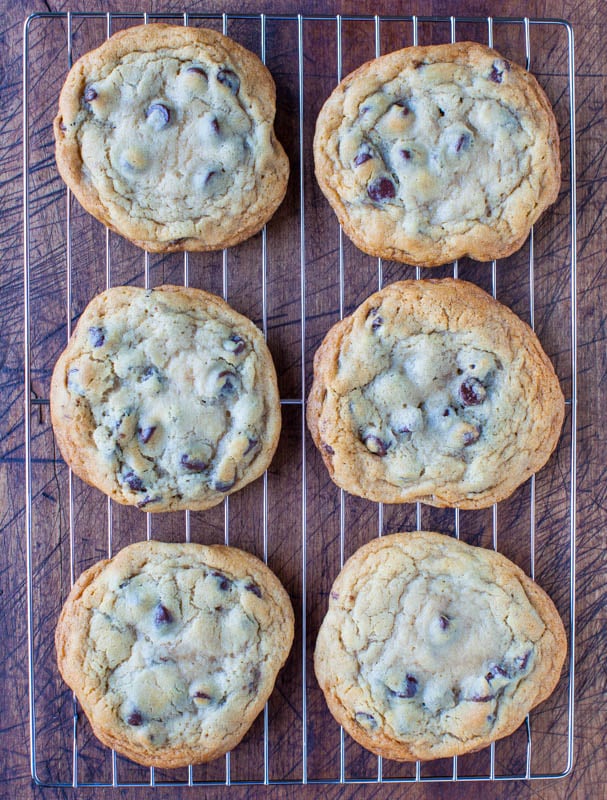
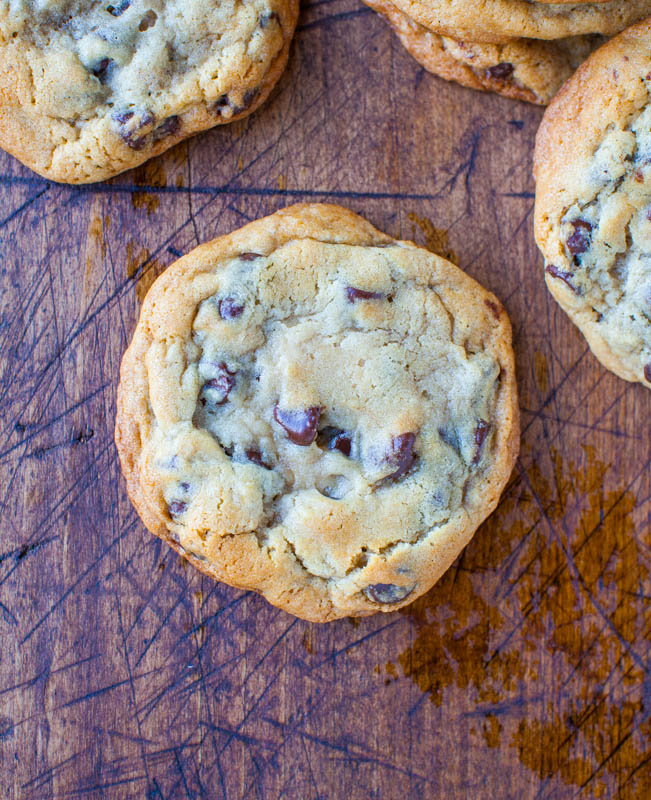
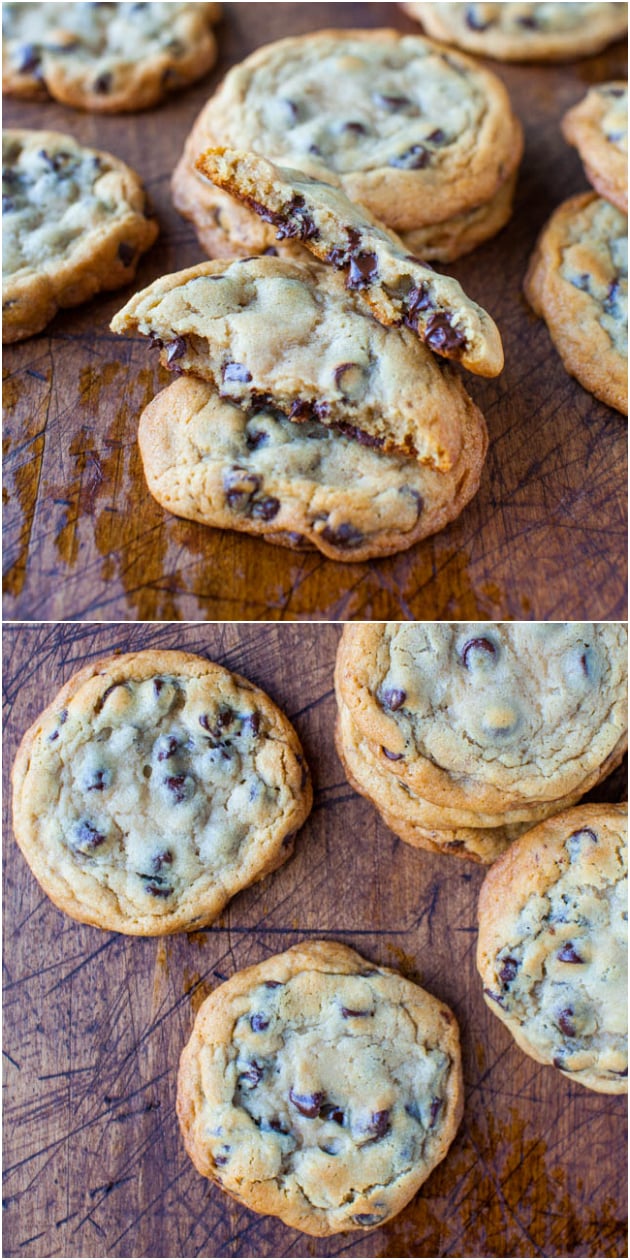

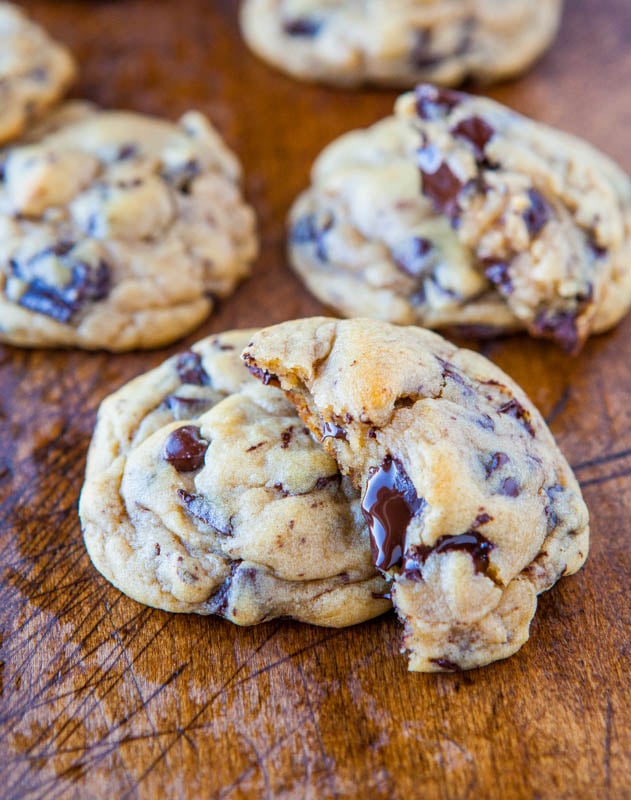
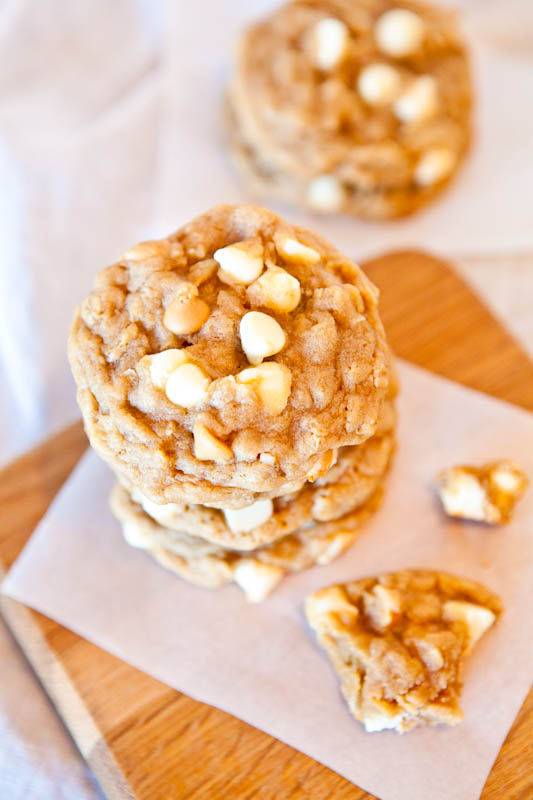
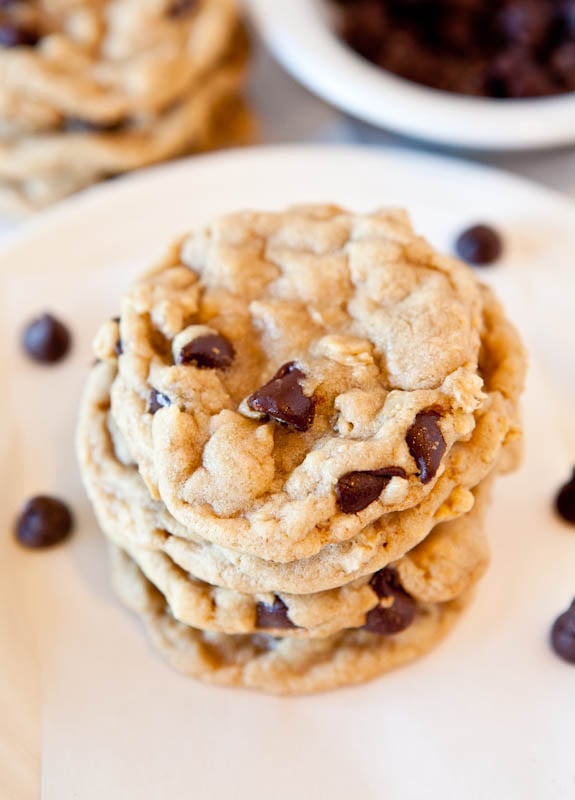
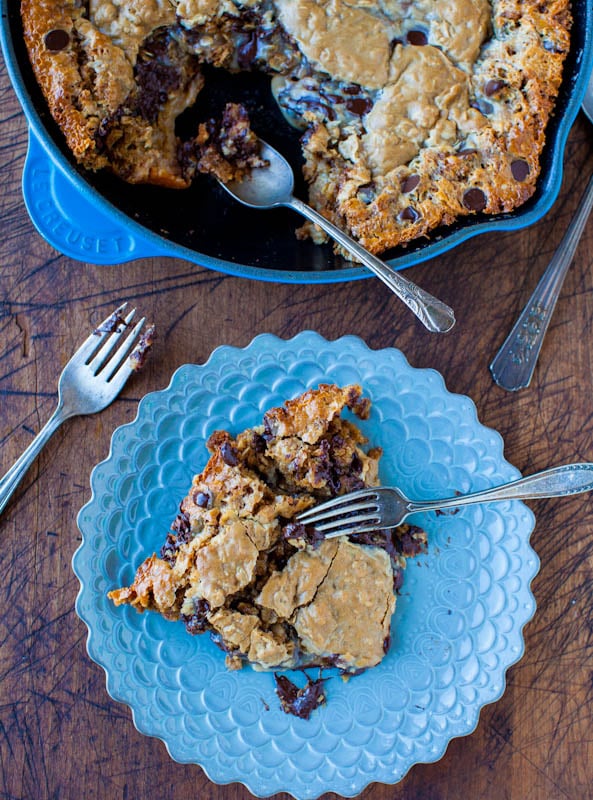
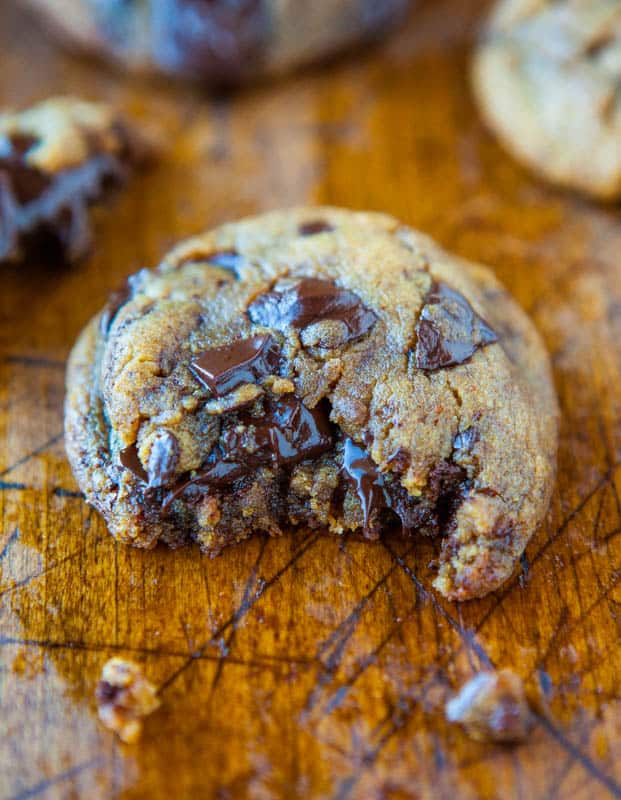
The cookies looks very crunchy! :) I love it.
And super thanks for sharing that recipe, will definitely try it.. I love cooking! <3 Hihi.
OMG! I followed the recipe with a scale and it was perfect. I didn’t have enough butter, so I used half margarine and half butter. Also, I only had dark brown sugar, so I replaced half of the 10 oz of brown sugar by white sugar. I cooked 1 cookie without refrigeration and the result was perfect: crunchy on the outside and chewy inside. The cookie was NOT puffy! Alleluia! Also, it had cracks on the top. I tried SO MANY recipes and neither of them were giving me the texture I wanted, but this one does. The texture was really perfect for me. However, I used regular chocolate chips, so the taste wasn’t extraordinary. I will certainly put this recipe in my favorites, but I will change it a little bit like put nuts, white chocolate, etc.
Thank you for this recipe and all your comments, it really helped me!
Sorry for the mistakes, I’m a french speaker!
Thanks again :)
Viviane
Thanks for trying the recipe and I’m glad it came out great for you!
wow Averie, thank you so much for this super thorough review of this recipe! I, like many of us, am also on the constant search for the “perfect” chewy chocolate chip cookie. Since I’m in Germany, I have the extra complication of testing out brown sugar substitutes and chopping up chocolate bars since I can’t easily find the chips. Perhaps it’s my homesick need for a good old fashioned American Chocolate Chip cookie that drives the crazy research desire…(or because I need to prove to all my german friends and family that Subway does NOT make the best cookie, just because it’s not crunchy from a package at the store!!!) At any rate, I also love recipe testing, and am also a big fan of the cooks illustrated version. I have yet to try the New York Times version that I’ve heard so many raves about, but since you were so detailed in you description (and I pretty much agree word for word with everything you said!) I feel like I don’t need to. Thanks for saving me the time! Keep up the good work
Wow, what a task you have. I bet there’s also a metric/conversion situation to contend with, too. Chopped chocolate isn’t the worst thing in cookies :) But trying to make your own brown sugar and get it just right, not the easiest. I’ve found about 1 cup white sugar to about 1 tablespoon molasses can work but it depends on the molasses, too. And it’s sticky and a pain. That’s crazy you can’t just buy it!
And after all you’re going through, yes, I would save yourself some time and take a pass on this recipe. Just my thoughts of course, but for the work involved, meh wasn’t worth it for me.
I have to say that these were the absolute WORST cookies I have ever eaten! I decided to make this recipe with a friend (who owns her own bakery) because the pictures looked so delicious, but these cookies were a complete let down. We followed each step exactly how it is outlined here, but the cookies tasted overwhelmingly like gluey flour and were not sweet at all, despite all the sugar. We followed the recipe exactly with no errors or substitutions, and they were still just awful. Those cheap Nestle cookies you get in the refrigerated section of the grocery store were 1000% better, and had way fewer ingredients! Save yourself the time, money, and effort and find an easier recipe that doesn’t include every type of flour in existence. You won’t regret it!
I just want to make it known for those who read this comment that this recipe was not created by me and I simply posted the New York Times recipe, which I cited and discussed at length in the post.
So your frustration, Melissa, is with THEIR recipe, not with me, I hope. I’m sorry they weren’t your favorites.